
The Thayer's Gull in Denmark
by Brian Small and Martin Birch,
with images contributed by Ian Boustead, Morten Bentzon Hansen and Ole Krogh
The recent sighting of a first winter 'Thayer's Gull' in Denmark (January 15-16th 2002) has once again rekindled the debate as to the identification, taxonomy and occurrence of thayeri in Western Europe. This 'subject' has been discussed many times before, most particularly in excellent articles in Birding World (Volume 11 no.3 and Volume 12 no.1) and in the most recent article by Howell and Elliot in Alula (4/2001). Nevertheless there is still much to reflect upon and the recent Danish bird provides us with yet another opportunity to study the field characteristics of this taxonomically confusing gull.
Reports of juvenile thayeri from Western Europe are well-documented but, as yet, struggle to excite less than avid gull enthusiasts. Hardly surprising given, according to Howell and Elliot, "its chequered taxonomic history". Treated by some authorities as a full species, Larus thayeri but by others as a dark-winged subspecies of Iceland Gull, Larus glaucoides, Howell and Elliot state that this is one of the most problematic field identification issues facing birders on either side of the pond.
The Danish bird was found on the 15th of January 2002 in the harbour of Hirtshals in Northern Denmark. Morten Bentzon Hansen takes up the story.
"The Thayer's Gull was found amongst some 500-600 Scandinavian Herring Gulls (Larus argentatus argentatus). The flock was feeding on fish waste put on the quay by a local fish exporter. The observer immediately thought 'Thayers', but did not go public with the record until he had another opinion on the identification. 15 birders saw the bird that day and they all agreed on the identification. The next day 30 birders assembled at the quay and they rediscovered the bird at the same place. However, by the 17th it was not located despite heavy searching from some 25 birders. Less than 75 people had the fortune to see this mega-rarity. It is, of course, the first sighting in Denmark. The harbour, itself, has hosted many rarities in the past including Ross Gull, Laughing Gull and Bonapartes Gull and as such is one of the best harbours in Denmark for rare gulls."
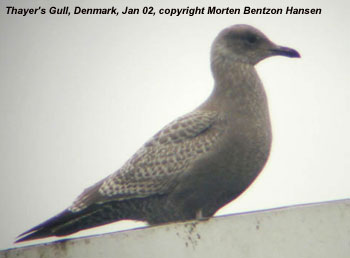 |
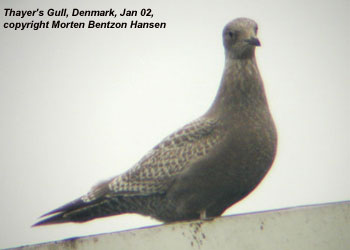 |
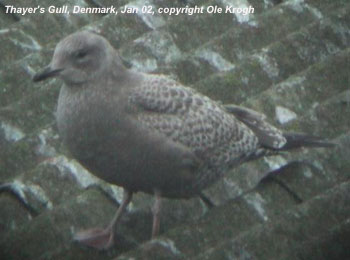 |
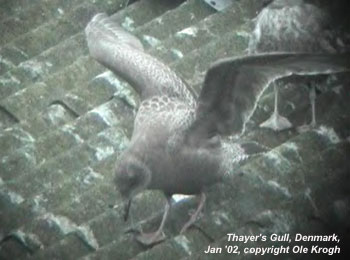 |
For more pictures of the Danish Thayer's Gull please visit please visit www.phyl.dk at the following site: http://www.phyl.dk/pictures.asp?id=t&t_id=2&m=pics&aar=2002
Although Thayer's Gull is generally thought of as a gull of the US west coast, there is no reason why it's regular occurrence in Western European waters should be doubted. McGeehan and Millington (Birding World (vol 11 no.3) have stated " Thayer's Gull is the most northerly breeding gull in the world and is a long distance migrant. The species breeds as close to the British Isles as northwest Greenland and the Arctic Islands of northeast Canada - home to Pale-bellied Brent Geese and Sabine's Gulls - which puts the species well within the vagrancy vector for birds travelling east across the North Atlantic towards the Western Palearctic. Put another way, the nearest Thayer's Gulls breed substantially closer to the British Isles than does Franklin's Gull, which has a well proven track record here."
So, whilst the question is no longer whether Thayer's Gull can occur in Western European waters, we are still left with the more tricky question of identification when it does. The 'spanner in the works' for birders searching for Thayer's Gull in European waters is, unfortunately, the appearance of dark kumlieni Iceland gulls, the possibility of hybrids and the variability of all forms, particularly Kumlieni.
Plumage and structure of the Danish bird.
The Danish bird shows well the rather small, long-winged and slim-bodied jizz considered to be useful in finding a Thayer's Gull amongst Herring Gulls. Clearly this bird, in a West European context, stood out to the Danish observers as obviously different to the argentatus Herring Gulls with which it was associating.
In the bottom left photo (above) the body appears an even (slightly faded) chocolate brown, though in other images the bird appears much paler, with a pale half-collar. The upperparts (mantle and scapulars) are centred with the same colour, but quite broadly tipped and notched white - with narrow sub-terminal anchor marks on the scapulars. The same pattern can be seen on the coverts, with the greater coverts prominently notched white, forming a chequered pattern. The tertials are darker, almost blackish with white notching on the distal half, and pale internal marks near the tip. The primaries are darker still (not quite black) with neat pale edges.
In appearance, the Danish bird is clearly very similar to the pure Thayer's Gulls that are regularly recorded in the western USA. Compare the images above with some highly educational shots taken by Ian Boustead at Doheny State Beach in Southern California in November 2001.

Moult.
One common aspect is moult, with all of the birds here in full juvenile plumage. Reference to Howell (Alula 4/2001), shows that this limited post-juvenile moult, with the first-calendar year moult lacking is typical (and indicative) of thayeri and glaucoides and consequently kumlieni, but is also present in some argentatus (Scandinavian Herring Gull) and smithsonianus (American Herring Gull).
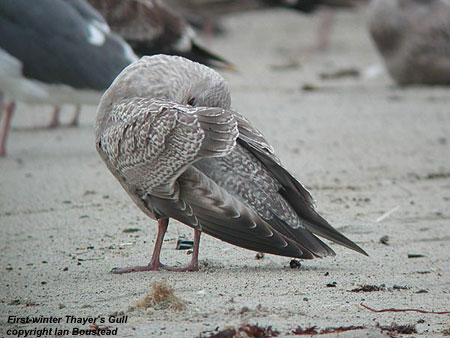
Note the following characteristic features (as described by Garner and McGeehan) in both the US bird and the Danish Bird :
1. primary projection is obviously long (easily seen on the Danish bird on the above pictures).
2. primaries are dark and normally the darkest part of the plumage (also easily seen on the Danish bird on the above pictures).
3. primary tips are highlighted by narrow pale fringes, forming thin chevrons (just visible in the third image of the Danish bird and even better on this picture: http://www.phyl.dk/pictures.asp?id=p&picture_id=254). .
4. tertials exhibit complex pale patterning concentrated toward the feather tip (visible on this image http://www.phyl.dk/pictures.asp?id=p&picture_id=254 as well. .
5. characteristic pattern to the scapulars (also see http://www.phyl.dk/pictures.asp?id=p&picture_id=248)
6. position of the eye, forward on the face and in a rounded head creating a soft, friendly appearance.
7. extensive barring to the undertail coverts and uppertail coverts (easily seen on the Danish bird here and at http://www.phyl.dk/pictures.asp?id=p&picture_id=245)
8. In flight, a venetian blind effect created by the contrast between the inner and outer webs of the primaries and secondaries. Use this link http://www.phyl.dk/pictures.asp?id=t&t_id=2&m=pics&aar=2002 to see more images of the Danish bird in flight and showing this effect.
9. bright pink leg colour (easily seen here and again at http://www.phyl.dk/pictures.asp?id=p&picture_id=254).

Much lighter Thayers Gull, approaching Kumlien's Gull in shade, but note patterning
of scapulars. Out of range, though, would it be identified as Thayer's Gull?
Other records of thayeri in Europe.
Reports of juvenile thayeri from Norway and Ireland are well-documented. The Norwegian bird was extremely well documented with good photographs and has been accepted to the national list. The Irish birds have also been well-watched. However, none of the birds in the republic have been accepted as yet as thayeri by the Irish Rare Birds Committee, although we understand the Belfast bird will be published as accepted by the Northern Ireland Birdwatchers Association Rarities Committee (NIBARC) in the next Northern Ireland Bird Report.
Dark kumlieni Iceland Gulls, intergrades and hybrids.
The unresolved puzzle for many in search of Thayer's Gull in European waters is the appearance of dark kumlieni Iceland gulls, the possibility of hybrids and the variability of all forms, particularly Kumlieni.
Indeed, the status of kumlieni is also open to question as it appears to be so remarkably variable and becoming increasingly dominant within the Iceland Gull taxon.
Whilst it is most unlikely that any argentatus could ever resemble the Danish bird can we be absolutely certain it is a Thayer's Gull ? One major problem is "what would a juvenile intergrade between kumlieni and thayeri look like?". Is it possible to rule this out for the Danish bird from the images and notes taken? For some the answer, based on current research, is still sadly 'no'.
Howell and Elliott (Alula 4/2001) conclude "The variation exhibited by adult 'kumlieni' appears unprecedented in any other single taxon of large white-headed gull. Indeed, whether this variable population deserves even a trinomial is a taxonomic problem, from which follows the question: of what would Kumlien's be a subspecies - Thayer's or Iceland?"
Many thanks to Ian Boustead, Morten Bentzon Hansen and Ole Krogh. Click here for Glaucous-winged Gull , presumed juvenile California Gull and juvenile Heerman's Gull pics from Ian's US trip.
Have you browsed John Idzikowski's photo-essay on adult Thayer's Gull at surfbirds - if not click here
